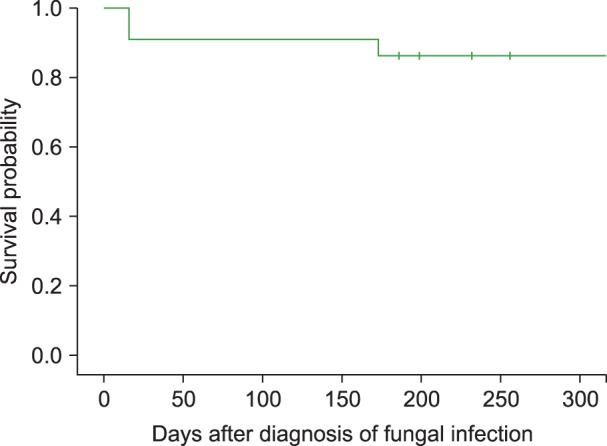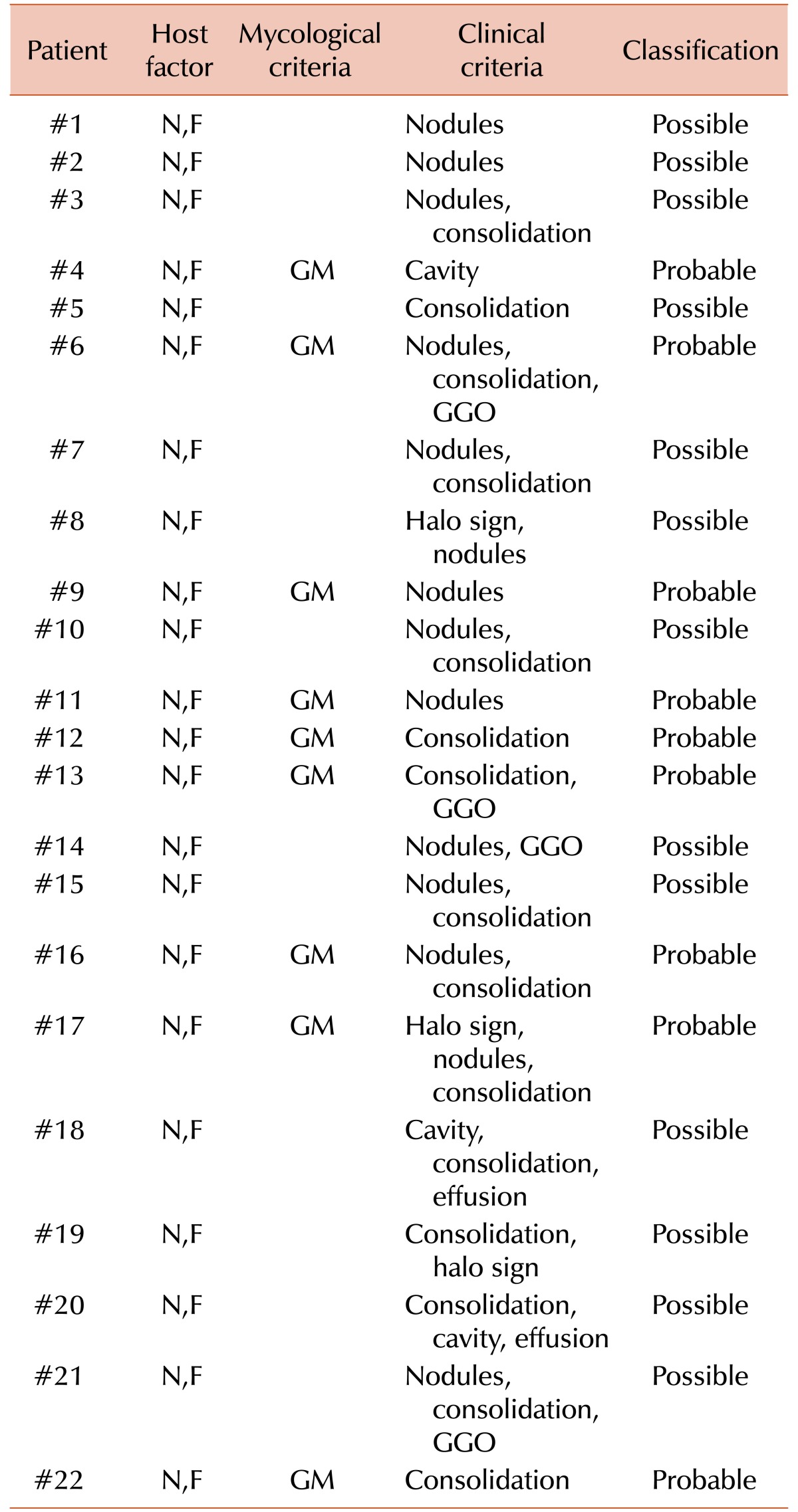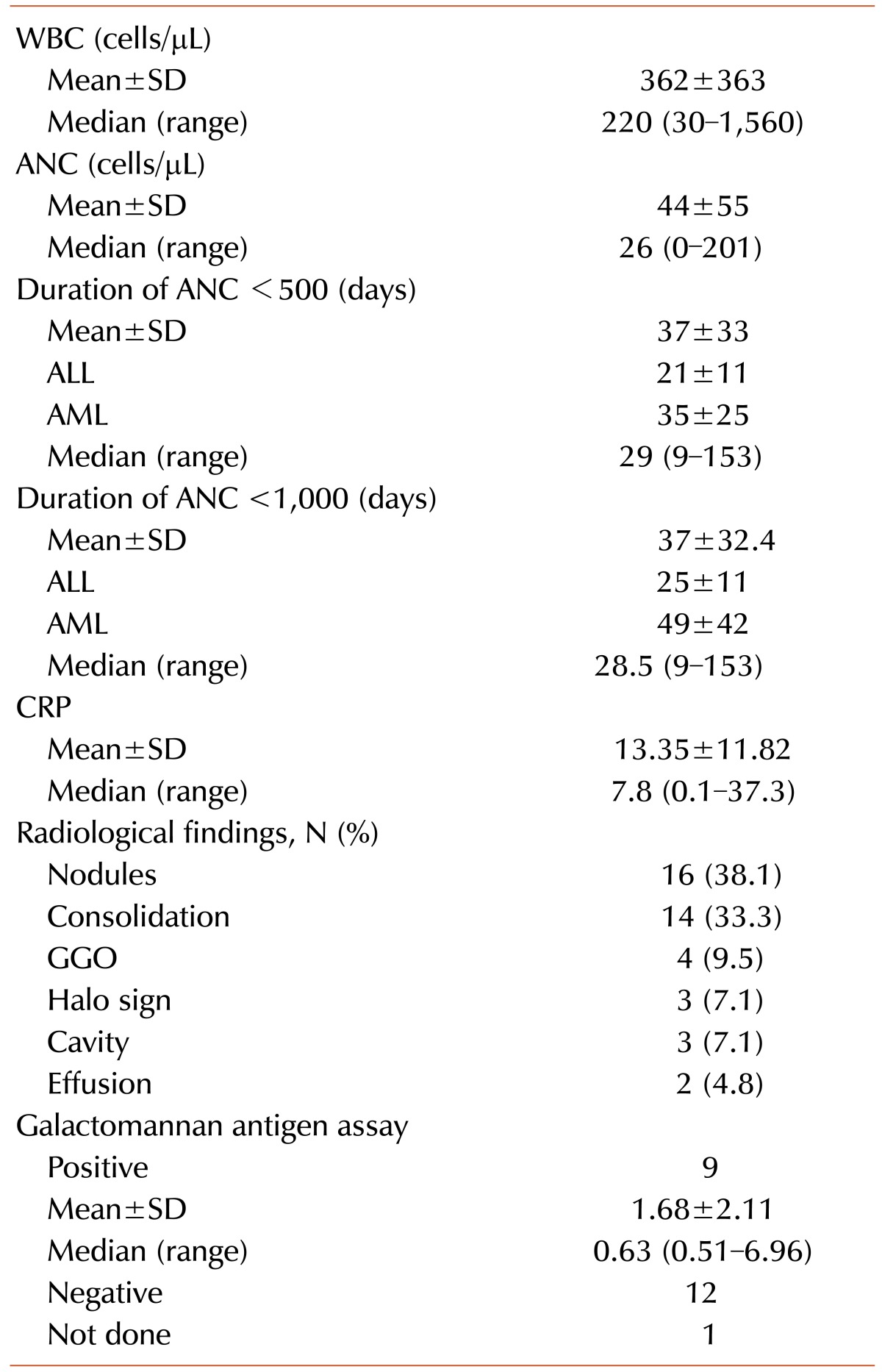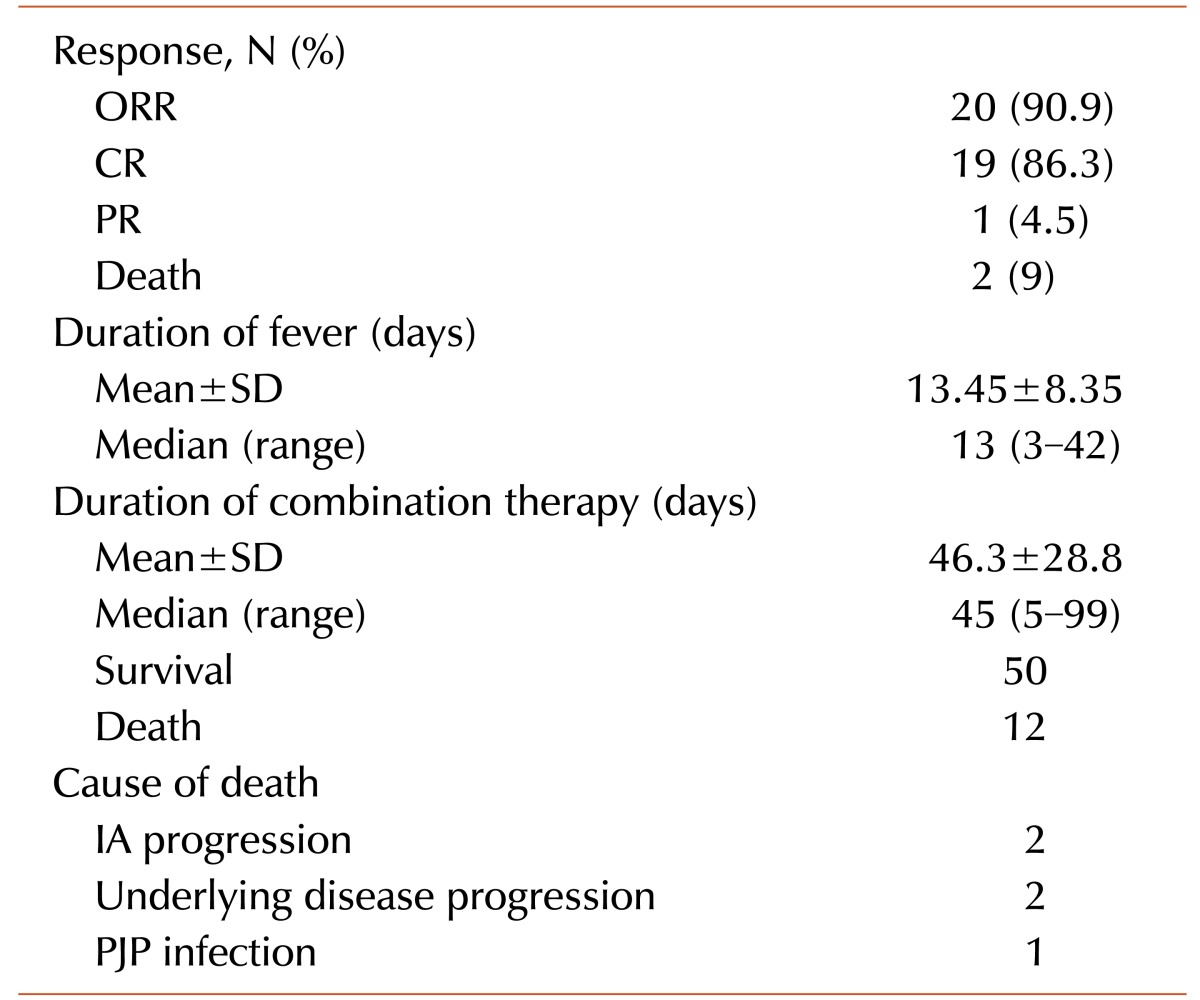Abstract
Background
Invasive fungal infections (IFIs) are a life-threatening problem in immunocompromised patients. Despite timely diagnosis and appropriate antifungal therapy, clinical outcomes of IFIs remain unsatisfactory, necessitating treatment with a combination of antifungal agents. Therefore, childhood leukemic patients treated with voriconazole plus caspofungin were evaluated for the safety and efficacy of the combination antifungal therapy to treat IFIs.
Methods
In this retrospective study, medical records were retrieved for patients admitted to the Pediatric Department of Yeungnam University Hospital, Daegu, South Korea, between April 2009 and May 2013. Medical records of 22 patients were analyzed.
Results
Of the 22 patients studied, nine (41%) had been diagnosed with probable IFI, and 13 (59%) with possible IFI. All patients, except one, were already receiving antifungal monotherapy for the treatment of neutropenic fever. After a diagnosis of IFI was confirmed, antifungal monotherapy was replaced with combination therapy. The study's overall response rate was 90.9%, with complete responses in 86.3% of the patients. Two patients experienced a side effect of a small increase in liver enzyme levels.
Treatment outcomes for childhood leukemia have improved over time. With recent advances in chemotherapy and supportive care, the overall survival rates of children with newly diagnosed acute lymphoblastic leukemia (ALL) and of those with myeloid neoplasms are now as high as 80% and 50%, respectively [12]. The development of supportive therapy has played an important role in the improvement of treatment outcomes.
Invasive fungal infections (IFIs) are significant causes of morbidity and mortality in pediatric cancer patients. Development of new antifungal drugs has remarkably improved the success rate of treatments; however, the mortality rate of IFI patients remains high. In addition, the efficacy of current antifungal drugs is suboptimal [3]. The development of a new antifungal drug requires considerable time; however, antifungal combination therapy (ACT) can be used as a complementary therapy to current IFI treatment. In vitro studies on ACT have shown that it is more effective than monotherapy; yet, ACT has been shown to have limitations when used in a practical clinical setting. In the study by Nivoix et al. [4], six refractory cases of invasive aspergillosis were treated with combination therapy, which likely caused one patient to develop hepatotoxicity.
Echinocandin antifungal agents, such as caspofungin (CAS), damage fungal cell walls by inhibiting beta-1,3-D-glucan synthase, and azole antifungal agents, such as voriconazole (VRC), are known to inhibit the synthesis of cell membranes. Studies have suggested that a combination of drugs from each of these classes would produce a synergistic effect because of their varied targets [567]. In addition, there have been case reports and a recently published prospective study from the Sorveglianza Epidemiologica Infezioni Fungine Emopatie Maligne (SEIFEM) group that evaluated the use of ACT to treat IFI in adults [8]. Further, the use of ACT based on CAS for pediatric hematology patients has been reported [459]. However, there have been no studies conducted in children with a single ACT (CAS+VRC).
Candida and Aspergillus species account for most IFIs [10]. The incidence of invasive aspergillosis (IA) is relatively low, but the infection can cause fatal complications in pediatric patients who are immunocompromised. The most common risk groups are pediatric patients suffering from hematological malignancies, those undergoing hematopoietic cell or solid organ transplants, and those receiving immunosuppressive therapies [11]. Therefore, in this retrospective study, we reviewed and analyzed the medical records of childhood leukemia patients with IFI who were treated with a combination of CAS and VRC to determine the safety and efficacy of this combination.
A total of 30 patients who had received a combination of CAS plus VRC for IFI were identified among 79 patients diagnosed with pediatric acute leukemia from April 2009 to May 2013 in the Pediatric Department of Yeungnam University Hospital, Daegu, South Korea. Of the patients who were initially identified, three were excluded from the study because they had been subsequently diagnosed with pneumonia not attributable to an IFI, and an additional five were excluded because they were diagnosed with non-infectious pulmonary infiltration. Medical records of the remaining 22 patients were retrospectively reviewed, and the following data were analyzed: demographic characteristics, underlying disease and disease states, radiological findings, and outcomes. None of the patients underwent stem cell transplantation before diagnosis of IFI. The study protocol was approved by the Institutional Review Board of Yeungnam University Hospital (IRB File No 2016-12-024).
Diagnosis of IFI was based on the criteria of the European Organization for Research and Treatment of Cancer/Invasive Fungal Infections Cooperative Group and the National Institute of Allergy and Infectious Disease Mycoses Study Group (EORTC/MSG) [12]. Patients were allocated to groups according to a diagnosis of proven, probable, or possible IFI. Patients with a positive serum galactomannan test result were classified as having invasive aspergillosis (IA). The day of diagnosis was defined as the day that the clinical team confirmed diagnosis of IFI.
According to the institutional guidelines, empirical antifungal treatment was initiated if fever persisted for more than 48 hours after initiation of empiric antibacterial treatment. ACT was initiated based on the patient's condition and clinician's subjective decision. Response to antifungal treatment was defined according to the current standard definition, which states that both complete responses (CR) and partial responses (PR) are considered as successful treatment, while all other responses are classified as treatment failures [13].
An enzyme immunoassay to detect Aspergillus galactomannan antigen in serum was performed using Platelia Aspergillus Ag (Bio-Rad Laboratories, Redmond, WA, USA). Results were interpreted based on the index calculated from the measured optical density, using a wavelength of 450 nm. Indices ≥0.5 were considered positive.
Comparison of overall response rate, overall survival rate and possible risk factors were estimated using Fisher's exact test. Overall survival was calculated using the Kaplan-Meier method from the date of diagnosis of IFI to the date of death from any cause or to the date of last follow-up. For all calculations, a P-value <0.05 was considered to be statistically significant. All statistical calculations were performed using SPSS 23.0 (IBM Corporation, Armonk, NY, USA).
The demographic characteristics of the patients are presented in Table 1. The study group was comprised of 11 boys and 11 girls, with a mean age of 5.3 years (range, 0.8–13.3 yrs); 11 patients had ALL, and 11 had acute myeloid leukemia (AML). None of the patients had undergone hematopoietic stem cell transplantation or immunosuppressive treatment prior to IFI onset. IFI diagnoses were classified as probable in nine patients (41%) and possible in 13 (59%) patients. Table 2 presents the patients' statuses for IFI diagnostic criteria.
All patients, with the exception of one, received empirical antifungal monotherapy with conventional amphotericin B, liposomal amphotericin B, or fluconazole (range of treatment duration, 1–21 days) before starting VRC plus CAS combination therapy. The remaining patient had already started combination antifungal therapy. Of the 22 patients, 21 patients received VRC plus CAS simultaneously, but one patient received the therapies consecutively, with 1–6 days between treatments. This patient was treated with VRC monotherapy, but the clinical symptoms did not improve and CAS was added.
When IFI was detected, 16 patients (nine ALL, seven AML) were in complete hematological remission (CHR). Of these 16 CHR patients, two had positive minimal residual disease, and they underwent re-induction chemotherapy at the time of IFI diagnosis. The remaining six patients (four ALL, two AML) had active hematological disease. Of the 22 patients, only two patients with ALL were diagnosed with IFI during maintenance chemotherapy. Of the remaining 20 patients, 18 (90.9%) were receiving intensive chemotherapy when IFI was detected. Of the patients with AML, six were diagnosed with IFI during induction therapy (Table 1). The median time between diagnosis of leukemia and the day of IFI diagnosis was 136.5 days (range, 12–1431 days).
After diagnosis of IFI, all 22 patients had severe neutropenia (absolute neutrophil count [ANC] <500 cells/µL), the median duration of which was 24.5 days (range, 3–91 days). The mean neutropenia (<500 cells/µL) duration of ALL and AML were 21±21 days and 35 days, respectively (P=0.193). The median ANC was 26 cells/µL (range, 0–201 cells/µL).
Nodules (38.1%) and consolidations (33.3%) were the most frequent radiologic findings in patients. A serum galactomannan (GM) assay was performed on 21 patients. Of these, nine patients had a GM index greater than 0.5, and the maximum GM index was 6.96. At diagnosis of IFI, the median C-reactive protein level was 7.8 mg/dL (range, 0.1–37.3 mg/dL) (Table 3).
The median duration of VRC plus CAS combination therapy was 45 days (range, 5–99 days). The median duration of the combination therapy in the 20 survivors was 50 days, while the median duration of the combination therapy in the two patients who died was 12 days (Table 3). One of the survivors was unresponsive to ACT and received a posaconazole replacement treatment. The loading and maintenance doses of CAS were 63.1±7.7 mg/m2 and 47.2±6.0 mg/m2, respectively. The loading and maintenance doses of VRC were 5.9±0.5 mg/kg and 3.6±0.6 mg/kg, respectively. The first patient who died had AML and was diagnosed with IFI during the consolidation phase, whereas the second patient who died had ALL and was diagnosed with IFI during the chemotherapy induction phase. None of the other patients experienced IFI relapse after remission during chemotherapy.
The 100-day survival rate after initiation of combination therapy was 90.9% (Fig. 1). Of the 22 patients, 20 (90.9%) responded to combination therapy (19 responded completely and one partially). The one patient with partial response received posaconazole replacement treatment. After 30 days of treatment, this patient showed a complete response. The remaining two patients died as a result of IA progression. Therefore, the 100-day treatment failure was three cases in total, and the 100-day IFI-free survival was 86.3%. An additional three patients subsequently died, with one fatality resulting from Pneumocystis jirovecii infection and two from leukemia progression (Table 4). In univariate analysis, no significant relationship was found between overall response to ACT or overall survival and age, gender, underlying disease, disease state, treatment phase, oxygen therapy, or intravenous immunoglobulin therapy.
VRC plus CAS combination therapy was well tolerated, except by two patients who had elevated liver enzyme levels, classified as grade 1 adverse event according to the Common Terminology Criteria for Adverse Events (CTCAE v4.03). The VRC dose was therefore reduced for one of these patients, although the other patient continued treatment without a reduction in antifungal drug dose. Neither patient stopped treatment because of side effects. While receiving VRC plus CAS combination therapy, 16 patients continued with anti-leukemic therapy. Of these 16 patients, the dose of anti-leukemic drugs was reduced for two patients.
IFI is a life-threatening infection in immunocompromised patients. Despite timely diagnosis and antifungal therapy, clinical outcomes of IFI are disappointing. The treatment success rate for IFI is 60% [14], while IFI-related mortality is 43–87.5% [151617]. The benefits of combination ACT for IFI are increased drug synergy and efficacy, and decreased resistance to antifungal drugs. The effectiveness of ACT has been proven in many recent experimental clinical studies. Arikan et al. [18] reported synergy of CAS plus amphotericin B (AMB), and Kirkpatrick et al. [19] reported that simultaneous VRC plus liposomal AMB was more effective than liposomal AMB alone. Cesaro et al. [5] used CAS-based ACT on 40 children and adolescents, and reported a favorable response in 53% of the patients and a 100-day survival rate of 70%.
Echinocandins are semisynthetic lipopeptide antifungal compounds that inhibit synthesis of β-1,3-D-glucan, an important component of cell walls in fungi. Therefore, echinocandins have the advantage of not affecting human cells without cell walls. In contrast, azole antifungals inhibit 14-α demethylase, suppressing the synthesis of ergosterol, a structural component of fungal membranes; as a result, membrane permeability increases, and fungal growth is inhibited. Thus, a synergistic effect has been predicted for ACT with these two antifungal agents because of their different mechanisms of action.
This study used VRC plus CAS combination therapy. In vitro and experimental animal model studies have reported that CAS plus VRC is more effective than monotherapy [620]. Lellek et al. [21] used CAS plus posaconazole therapy on adult patients and reported a favorable response in 77% of patients. Raad et al. [22] conducted a clinical study that used a single combination of CAS plus VRC therapy in IA. Herbrecht et al. [23] reported 59 proven, 178 probable, and 106 possible IA patients who underwent VRC vs. AMP monotherapy, with a 12-week response rate of 54.7% vs. 29.9%, respectively. In Candoni et al. [3], an 80% (28/35) overall response rate in CAS plus VRC, 70% (14/20) in CAS plus AMP and 73% (11/15) in VRC plus CAS were obtained. To date, there has been no clinical study on CAS plus VRC for children with IA. Given the synergistic effect of CAS plus VRC combination, the reduction in drug resistance and excellent expected therapeutic effect, the combination of both agents has been used to treat IFI in pediatric cancer patients.
In the present study, IFI-related death mortality was 9%, and the 100-day survival rate after initiation of combination therapy was 90.9%. ACT did not result in IFI control in only in 3 of the 22 patients. To the best of our knowledge, these values are considerably better than those reported in other studies. Data from L'Associazione Italiana ematologia ed Oncologia Pediatrica (AIEOP) showed that the overall mortality rate from fungal infections in children with cancer was 28%. Moreover, in patients with deep tissue mycoses, the mortality rate was 59% in children with probable invasive infection and 30% in those with possible invasive infection. ACT was used to treat 49% of the fungal infection cases [24]. In patients treated with ACT, there was a favorable response rate of 53% and the 100-day survival rate was 70% [5]. The same team also reported that the risk of death was higher (3.8-fold) in patients already receiving antifungal therapy at the time of diagnosis. In this study, all patients, with the exception of one, received antifungal monotherapy at the time of diagnosis. Nevertheless, this study's survival rates after implementing ACT were higher than those in previous studies.
Neutropenia is a risk factor for IFI, and the longer the duration of neutropenia, the higher the risk of IFI. The duration of neutropenia affects the response and mortality rate of IFI [25]. In this study, the median duration of neutropenia was 37±33 days. Raad et al. [22] reported that the median duration of neutropenia was 15 days (1–50 days) in primary therapy and 21 days (2–70 days) in salvage therapy. Caillot et al. [26] reported that the median duration of neutropenia was 15 days (3–58 days) in L-AMB monotherapy vs. 31.5 days (3–115 days) in L-AMB plus CAS ACT. Therefore, in this study, ACT could be considered to have better therapeutic results despite the longer duration of neutropenia, as compared with previous studies. However, the citations mentioned above mostly refer to studies in adults. Hence, this is a limitation as we cannot generalize our results to children.
Recently, other studies have explored differences in the effectiveness of treatments according to dosage and have devised measures to minimize drug toxicity, while conducting ACT along with therapeutic drug monitoring [2728]. Unfortunately, a pharmacological study to determine the optimal dosage to minimize the side effects of CAS plus VRC ACT could not be conducted simultaneously with our study. Regardless, we observed only minimal adverse effects during ACT. In previous studies, hypokalemia, as well as liver, renal, and neurologic toxicity were mentioned as side effects of ACT. We had chosen to use VRC because of concerns about severe nephrotoxicity of amphotericin B [2329].
This study has several limitations. First, this was a retrospective study with no uniform application criteria. Second, the study only reports results from a single institute. Lastly, there is a lack of microbiological confirmation of non-aspergillosis fungal infection. However, other studies have reported the results of treatment for small numbers of patients using various combinations of antifungal agents. Nevertheless, this is the first study that evaluated the efficacy and safety of ACT with CAS plus VRC. No previous study has reported treatment results and safety of this ACT in pediatric leukemia patients.
In conclusion, VRC plus CAS combination therapy is an effective and safe treatment for serious invasive fungal infection in pediatric acute leukemia patients. However, prospective studies on this ACT that include more pediatric patients with IFI are needed.
References
1. Cooper SL, Brown PA. Treatment of pediatric acute lymphoblastic leukemia. Pediatr Clin North Am. 2015; 62:61–73. PMID: 25435112.

2. Advani AS, Hunger SP, Burnett AK. Acute leukemia in adolescents and young adults. Semin Oncol. 2009; 36:213–226. PMID: 19460579.

3. Candoni A, Caira M, Cesaro S, et al. Multicentre surveillance study on feasibility, safety and efficacy of antifungal combination therapy for proven or probable invasive fungal diseases in haematological patients: the SEIFEM real-life combo study. Mycoses. 2014; 57:342–350. PMID: 24373120.

4. Nivoix Y, Zamfir A, Lutun P, et al. Combination of caspofungin and an azole or an amphotericin B formulation in invasive fungal infections. J Infect. 2006; 52:67–74. PMID: 16368463.

5. Cesaro S, Giacchino M, Locatelli F, et al. Safety and efficacy of a caspofungin-based combination therapy for treatment of proven or probable aspergillosis in pediatric hematological patients. BMC Infect Dis. 2007; 7:28. PMID: 17442100.

6. Kirkpatrick WR, Perea S, Coco BJ, Patterson TF. Efficacy of caspofungin alone and in combination with voriconazolein a Guinea pig model of invasive aspergillosis. Antimicrob Agents Chemother. 2002; 46:2564–2568. PMID: 12121933.
7. Kulemann V, Bauer M, Graninger W, Joukhadar C. Safety and potential of drug interactions of caspofungin and voriconazole in multimorbid patients. Pharmacology. 2005; 75:165–178. PMID: 16192747.

8. Barraco D, Carobolante F, Candoni A, et al. Complete and long-lasting cytologic and molecular remission of FIP1L1-PDGFRA-positive acute eosinophil myeloid leukaemia, treated with low-dose imatinib monotherapy. Eur J Haematol. 2014; 92:541–545. PMID: 24460680.
9. Hatipoglu N, Hatipoglu H. Combination antifungal therapy for invasive fungal infections in children and adults. Expert Rev Anti Infect Ther. 2013; 11:523–535. PMID: 23627858.

10. Groll AH, Castagnola E, Cesaro S, et al. Fourth European Conference on Infections in Leukaemia (ECIL-4): guidelines for diagnosis, prevention, and treatment of invasive fungal diseases in paediatric patients with cancer or allogeneic haemopoietic stem-cell transplantation. Lancet Oncol. 2014; 15:e327–e340. PMID: 24988936.

11. Choi SH, Kang ES, Eo H, et al. Aspergillus galactomannan antigen assay and invasive aspergillosis in pediatric cancer patients and hematopoietic stem cell transplant recipients. Pediatr Blood Cancer. 2013; 60:316–322. PMID: 23042761.
12. De Pauw B, Walsh TJ, Donnelly JP, et al. Revised definitions of invasive fungal disease from the European Organization for Research and Treatment of Cancer/Invasive Fungal Infections Cooperative Group and the National Institute of Allergy and Infectious Diseases Mycoses Study Group (EORTC/MSG) Consensus Group. Clin Infect Dis. 2008; 46:1813–1821. PMID: 18462102.

13. Segal BH, Herbrecht R, Stevens DA, et al. Defining responses to therapy and study outcomes in clinical trials of invasive fungal diseases: Mycoses Study Group and European Organization for Research and Treatment of Cancer consensus criteria. Clin Infect Dis. 2008; 47:674–683. PMID: 18637757.
14. Kurosawa M, Yonezumi M, Hashino S, et al. Epidemiology and treatment outcome of invasive fungal infections in patients with hematological malignancies. Int J Hematol. 2012; 96:748–757. PMID: 23111539.

15. Choi SH, Lee SY, Hwang JY, et al. Importance of voriconazole therapeutic drug monitoring in pediatric cancer patients with invasive aspergillosis. Pediatr Blood Cancer. 2013; 60:82–87. PMID: 22887791.

16. Rubio PM, Sevilla J, González-Vicent M, et al. Increasing incidence of invasive aspergillosis in pediatric hematology oncology patients over the last decade: a retrospective single centre study. J Pediatr Hematol Oncol. 2009; 31:642–646. PMID: 19684521.
17. Crassard N, Hadden H, Piens MA, et al. Invasive aspergillosis in a paediatric haematology department: a 15-year review. Mycoses. 2008; 51:109–116. PMID: 18254746.

18. Arikan S, Lozano-Chiu M, Paetznick V, Rex JH. In vitro synergy of caspofungin and amphotericin B against Aspergillus and Fusarium spp. Antimicrob Agents Chemother. 2002; 46:245–247. PMID: 11751145.
19. Kirkpatrick WR, Coco BJ, Patterson TF. Sequential or combination antifungal therapy with voriconazole and liposomal amphotericin B in a Guinea pig model of invasive aspergillosis. Antimicrob Agents Chemother. 2006; 50:1567–1569. PMID: 16569887.

20. Perea S, Gonzalez G, Fothergill AW, Kirkpatrick WR, Rinaldi MG, Patterson TF. In vitro interaction of caspofungin acetate with voriconazole against clinical isolates of Aspergillus spp. Antimicrob Agents Chemother. 2002; 46:3039–3041. PMID: 12183266.
21. Lellek H, Waldenmaier D, Dahlke J, et al. Caspofungin plus posaconazole as salvage therapy of invasive fungal infections in immunocompromised patients. Mycoses. 2011; 54(Suppl 1):39–44.

22. Raad II, Zakhem AE, Helou GE, Jiang Y, Kontoyiannis DP, Hachem R. Clinical experience of the use of voriconazole, caspofungin or the combination in primary and salvage therapy of invasive aspergillosis in haematological malignancies. Int J Antimicrob Agents. 2015; 45:283–288. PMID: 25455847.

23. Herbrecht R, Patterson TF, Slavin MA, et al. Application of the 2008 definitions for invasive fungal diseases to the trial comparing voriconazole versus amphotericin B for therapy of invasive aspergillosis: a collaborative study of the Mycoses Study Group (MSG 05) and the European Organization for Research and Treatment of Cancer Infectious Diseases Group. Clin Infect Dis. 2015; 60:713–720. PMID: 25414266.

24. Castagnola E, Cesaro S, Giacchino M, et al. Fungal infections in children with cancer: a prospective, multicenter surveillance study. Pediatr Infect Dis J. 2006; 25:634–639. PMID: 16804435.
25. Cornely OA, Maertens J, Bresnik M, et al. Liposomal amphotericin B as initial therapy for invasive mold infection: a randomized trial comparing a high-loading dose regimen with standard dosing (AmBiLoad trial). Clin Infect Dis. 2007; 44:1289–1297. PMID: 17443465.

26. Caillot D, Thiébaut A, Herbrecht R, et al. Liposomal amphotericin B in combination with caspofunginfor invasive aspergillosis in patients with hematologic malignancies: a randomized pilot study (Combistrat trial). Cancer. 2007; 110:2740–2746. PMID: 17941026.
27. Siopi M, Siafakas N, Vourli S, Mouton JW, Zerva L, Meletiadis J. Dose optimization of voriconazole/anidulafungin combination against Aspergillus fumigatus using an in vitro pharmacokinetic/pharmacodynamic model and response surface analysis: clinical implications for azole-resistant aspergillosis. J Antimicrob Chemother. 2016; 71:3135–3147. PMID: 27494912.
28. Zembles TN, Thompson NE, Havens PL, Kaufman BA, Huppler AR. An optimized voriconazole dosing strategy to achieve therapeutic serum concentrations in children younger than 2 years old. Pharmacotherapy. 2016; 36:1102–1108. PMID: 27548272.

29. Kontoyiannis DP, Hachem R, Lewis RE, et al. Efficacy and toxicity of caspofungin in combination with liposomal amphotericin B as primary or salvage treatment of invasive aspergillosis in patients with hematologic malignancies. Cancer. 2003; 98:292–299. PMID: 12872348.





 PDF
PDF ePub
ePub Citation
Citation Print
Print







 XML Download
XML Download